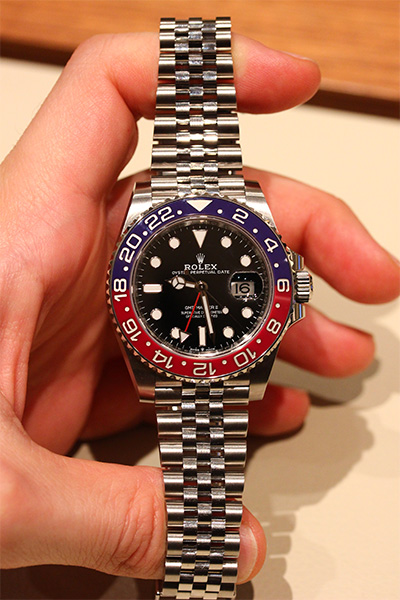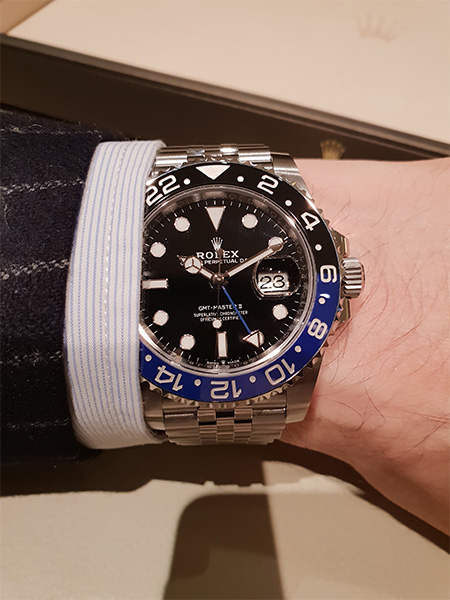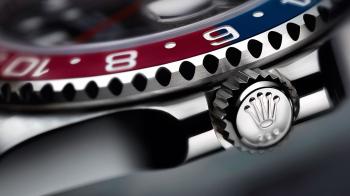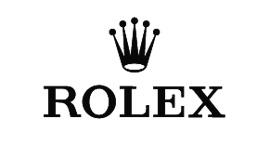Pepsi and Batman – the hottest nicknames in contemporary watchmaking. They come from the bezel colours of two watches – the former red and blue, the latter black and blue – colourways that are associated with the aforementioned refreshing beverage and superhero, respectively. They are the names given to two references of the original Rolex dual time-zone travel watch, the GMT-Master II: references 126710 BLRO (BLeue, ROuge) and 126710 BLNR (BLeue, NOire).
The former reignited public desire for a watch that has been in existence for 65 years, with regular reissues and updates. The GMT-Master was one of the first true travel watches, with a central hand for the second time zone performing one revolution every 24 hours, and the time read off the bezel. The Pepsi, however, was gone from the Rolex catalogue for years. In 2014 a very heavy, very expensive white gold version whetted the appetite of the many fans of the watch, which had been worn by Pan-Am pilots and Thomas Magnum P.I., amongst others, and thousands of lovers of sporty, durable, sturdy travel watches.
Then in 2018, out of nowhere, Rolex launched the Pepsi in steel, not with the sporty triple-link Oyster bracelet, but on a Jubilee bracelet. This flexibly articulated strap with its five small links had vanished from the catalogues over 20 years ago. The Ref. 126710, a dressier and more unusual GMT-Master II, caused an immediate sensation. The waiting list for one of these watches, new from a store, is at least as long as that for a steel Cosmograph Daytona – the ultimate elusive watch. You have to be prepared for a 3- to 5-year wait. At least.

But as an inevitable consequence of market forces, the watch is in fact widely available “new pre-owned” or “new unworn”. These coy terms refer to pieces supplied by a high-stakes resellers’ market for models that are unavailable in stores. It’s a highly organised network made up of hundreds of individuals. Although they don’t coordinate their actions, they operate using the identical tactic of adding their names to the waiting lists of several Rolex retailers. Then, they make the most of the good relationship they have with the stores, or they play a waiting game. As soon as the watch is delivered, they advertise it for sale on specialised websites, usually second-hand sites, and pocket a risk-free and substantial profit. But buyers don’t get off so lightly. The markup is a minimum of 95%! That’s the price of immediacy.
At Baselworld in 2019, Rolex expanded the concept further, adding the Ref. 126710BLNR, a GMT-Master II Batman, also on a Jubilee bracelet. Here, several factors coincided: genuine interest in this model, which was already highly sought-after (although less so than the Pepsi); contagion from the previous year’s new model; and growing enthusiasm for Rolex’s Professional models. The miracle happened again: the watch was impossible to get hold of in stores, but was widely available to anyone prepared to pay a 100% premium.

What was even more astonishing was that the phenomenal success of the new Pepsi rubbed off on older models. The leading online watch resale site, Chrono24, published a study on the price of the model across all references. From mid-2014, when the white gold Pepsi was introduced, the various references increased in price by between 40% and 100%. So... since when does the success of new models have a similar effect on vintage? It’s a rare phenomenon, and one that usually works in the opposite direction.
In general, and looking at brands other than Rolex, some highly sought-after models that are produced in numbers designed to promote rarity, from brands in vogue, no longer have any acknowledged official retail price. It’s the market price, dictated by what clients in a hurry are prepared to shell out, that counts. And that price is significantly higher than what the watchmakers themselves are asking. In 2017 Patek Philippe, realising what was happening, increased the price of the steel Nautilus Ref. 5711 1/A by almost 50%, to bring it up to the actual market price. Because, after all, why should the watchmaker not get a cut too? Particularly when clients are prepared to pay a premium to someone whose only virtue is to be closer to the front of the queue.





